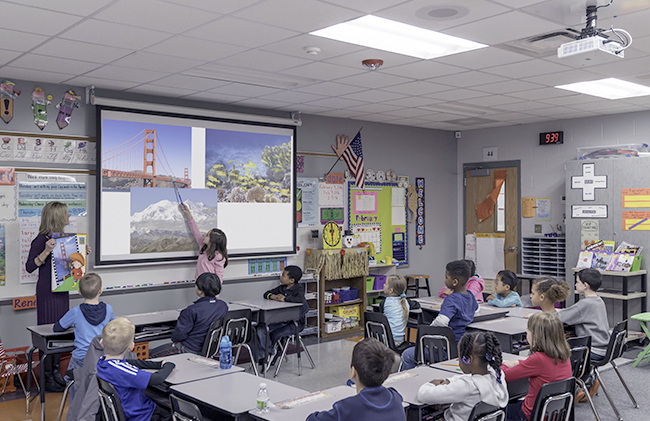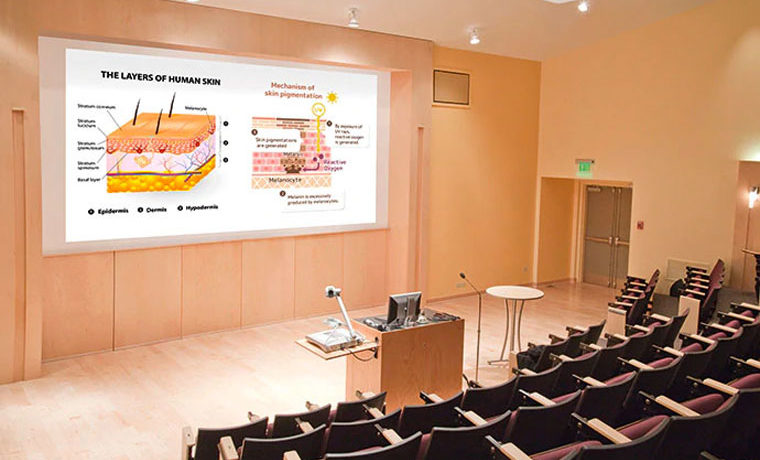Welcome to Our Annual Classroom Projector Report!
This year, we cover projectors used in K–12 schools, colleges, universities, and museums. Our focus isn’t just specs—it’s about how projectors work in real classrooms.
Types of Projectors
We group projectors into three main categories:
Standard Projectors: Budget-friendly, common in K–12 classrooms.
Large Venue Projectors: For lecture halls, auditoriums, and multipurpose spaces.
High-End / Specialty Projectors: Digital signage, projection mapping, or museum use.
Projectors come in standard throw, short throw, and ultra-short throw designs, which affect price and installation. Some offer full interactivity; others don’t. We also include at least one XGA (4:3) model for schools replacing older projectors. Networking is essential today.
What’s in the Report
We reviewed about 15 new models and included 9 award-winning projectors from last year. The report includes:
Short summaries of each projector
Recommendations for real classroom use
Links to full reviews
Many projectors have “sibling” models with slight variations, so this guide actually covers nearly 100 options. And award-winning models from previous years are often still available—and sometimes cheaper!
Interactive Projectors
Interactive models are growing in popularity, often mounted above whiteboards. Past award winners are included if still available and widely stocked.
Other Considerations
We also cover:
Operating costs (lamps, filters, maintenance)
Light sources: lamp, laser, or LED
Networking & automation
3D support (not a focus this year)
New Trends This Year
Laser Projectors: Replacing lamps in Higher Ed and Specialty categories. Low maintenance makes them cost-effective over time.
Affordable Lasers: Many brands offer WUXGA/1080p or WXGA/720p lasers under $2,500.
Ultra Short Throw (UST) Projectors: Popular for interactive classrooms and large lecture halls.
Networking & High-End Features: Multiple lenses, projection mapping, edge blending.
Resolution Trends: K–12: WVGA/720p or WUXGA/1080p; Higher Ed: WUXGA/1080p (4K growing in STEM/art).
ALR Screens: Help projectors perform better in bright rooms; new motorized versions now available.
Tele-Learning & Remote Teaching: Large screens help social distancing; home projectors can simulate multiple monitors for teachers.
We focus on the most interesting and capable projectors, avoiding “me-too” models. The goal is to help you find the best tools for effective learning, whether in a classroom, university, or museum.
2020-2021 Best in Classroom: K-12 Classroom Projector Award Winners
The following projectors won awards in the K-12 Classroom Projector Category:
Best in Classroom Smartest K-12 Projector Award: BenQ EW800ST
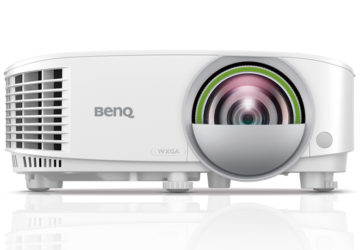
The BenQ EW800ST is a short-throw DLP projector with WXGA (1280 × 800) resolution and some smart features. It’s mainly designed for classrooms but also works well in conference or meeting rooms. BenQ calls it “interactive,” but unlike other interactive projectors, it doesn’t support finger-touch or pen annotation. Instead, its smart features focus on making teaching and presenting more efficient.
We’ll start with a quick overview and highlight its main features. Then we’ll look at the hardware, dive into picture quality and performance, and wrap up with a summary, including how it compares to other projectors, plus its pros and cons.
This award goes to products that stand out—either they’re excellent but a bit rough around the edges, or they’re high-quality but designed for a specific purpose..
Price: $999
Technology: DLP
Resolution: WXGA (1280×800)
Brightness: 3,300 lumens
Contrast: 20,000:1
Zoom: Fixed
Lens Shift: No
Lamp Life: 5,000 hours
Weight: 6 lbs
Warranty: Standard
Overview
Normal Mode: 5,000 hours → About 4.6 years if used 6 hours/day for a 180-day school year
ECO Mode: 10,000 hours → About 9.3 years with the same daily use
WXGA is sharp enough for most K–12 classrooms. Higher resolutions are usually only needed for specific cases—like video production, photography, yearbook, or graphic design classes. In higher education, WUXGA can be useful, while 4K is mostly reserved for specialized fields like medical imaging, scientific simulations, architecture, or film and design work.
At $999, it’s a great deal for a smart “interactive” projector. While it doesn’t include pens or touch functions like typical interactive projectors, it has several handy features that earned it our Special Interest Award.
Key Highlights:
Bright at 3,300 lumens
Sharp WXGA resolution (1280×800)
Long lamp life: 5,000–10,000 hours
Short throw with fixed lens
2-watt mono speaker
Quiet fan: 33 dB (full power), 29 dB (ECO)
Smart features: Personal cloud storage, BenQ Smart Control App, Infographic Mode, Wi-Fi (dongle included), Bluetooth
3D ready
Anti-dust sensor
Supports HID-compliant mice
Best in Classroom Performance Award: Christie LWU-530
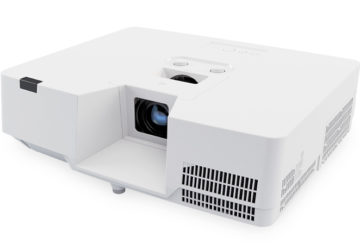
The Christie LWU530-APS is a 5,000-lumen laser projector with WUXGA resolution that can handle content up to 4K. It’s designed for classrooms, boardrooms, and small auditoriums.
Christie is known for high-quality, premium projectors, but the APS series focuses on reliability, flexibility, and strong performance at a more affordable price. The APS line is Christie’s most budget-friendly option.
There are two models in the APS series: the LWU530-APS (5,000 lumens) and the LWU650-APS (6,000 lumens, $3,249).Both are WUXGA laser projectors with engines rated for up to 20,000 hours
Price: [Not listed]
Technology: 3LCD
Native Resolution: 1920 x 1200 (WUXGA)
Brightness: 5,000 ANSI lumens
Contrast Ratio: 3,000,000:1
Zoom Lens Ratio: Fixed
Lens Shift: No
Lamp/Laser Life: [Not listed]
Weight: [Not listed]
Warranty: [Not listed]
Overview
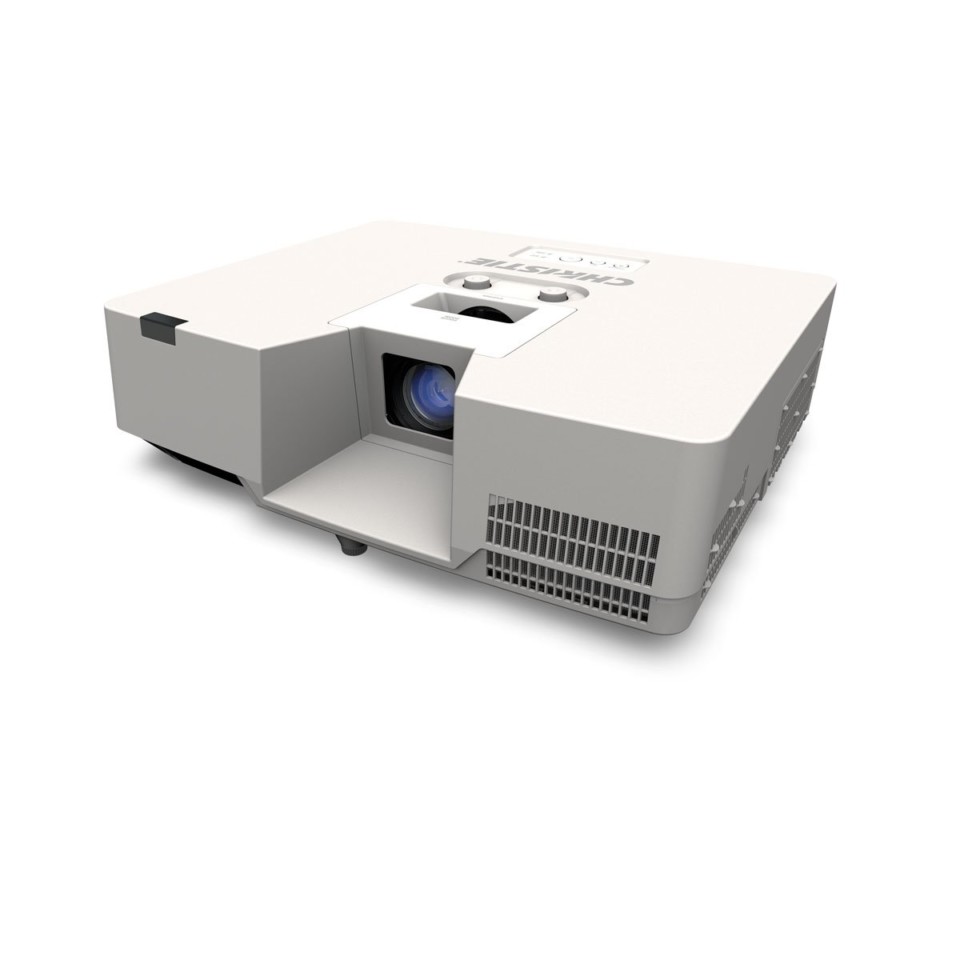
The Christie LWU530 is a reliable mid-brightness business-class projector, offering up to 5,000 lumens thanks to its long-lasting laser light engine. Part of Christie’s APS-Series, it delivers solid performance for classrooms, conference rooms, or boardrooms without breaking the budget.
It has a native WUXGA resolution (1920 x 1200) and can handle 4K@30P content. Christie rates its dynamic contrast at 3,000,000:1. While it can’t match the black levels of home theater projectors in the same price range, its high brightness still produces good-looking blacks even in rooms with some ambient light.

Christie LWU530 produces images with rich colors
The Christie LWU530 uses a laser light engine that can last up to 20,000 hours at full power. As a 3LCD projector, it delivers the same brightness for color as it does for white, giving vibrant, clear images in classrooms, meeting rooms, or mid-size lecture halls.
Highlights:
5,000 lumens (color and white)
Supports 4K@30p content and Blu-ray UHD
Dynamic iris for deeper blacks
20,000-hour laser life
Split-screen options (PoP and PiP)
Manual vertical/horizontal lens shift
HDBaseT for long HDMI runs over CAT6
DICOM Simulation Mode for medical imaging
Easily share content from PC or mobile via LAN
Advanced networking standard; wireless optional
Can be mounted vertically or at any angle
Supports 24/7 operation
Best in Classroom Price Performance Award: NEC NP-MC382W
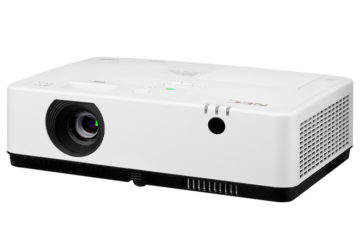
The NEC NP-MC382W is a versatile, portable LCD projector ideal for business and education. With WXGA (1280×800) resolution, it’s easy to move between classrooms, meeting rooms, or boardrooms. Its features make it suitable for a wide range of uses, from K–12 classrooms and conference rooms to exhibitions and retail spaces.
With 3,800 lumens, this projector handles typical ambient light well. This review will cover an overview, key features, hardware details, and a closer look at picture quality and performance, finishing with a summary of pros, cons, and how it stacks up against the competition.
NEC NP-MC382W Specs
Price: –
Technology: LCD
Resolution: WXGA (1280×800)
Brightness: 3,800 lumens
Contrast: 16,000:1
Zoom Lens Ratio: –
Lens Shift: –
Lamp Life: –
Weight: –
Warranty: –Overview
NEC is well known in the business and education markets, making projectors from entry-level to large-venue models. The first NEC I reviewed was a WUXGA pixel-shifter with 4K capability and excellent picture quality, which even won an award in our Classroom Projectors Report. My expectations for NEC projectors have stayed high—and so far, they haven’t disappointed.
The NEC NP-MC382W shows strong color performance, as seen in images like Journey to Space.
This projector has WXGA resolution (1280×800)—the business and education equivalent of 720p—but it can accept 4K content. NEC even says it’s “fully upgradable to 4K,” giving it a longer lifespan as technology evolves. With LCD technology, the lamp lasts up to 10,000 hours at full power and 15,000 hours in ECO mode, which helps lower ownership costs.
The NP-MC382W is an entry-level business and education projector with multiple color modes and great color quality.
It’s also designed for easy management. NEC’s free NaViSet Administrator 2 software lets you control multiple projectors from one location, and it’s Crestron RoomView compatible for managing projector fleets across different brands—perfect for schools or businesses.
The NEC NP-MC382W does a great job with skin tones—here’s a photo taken in Video Mode.
It’s packed with features for presentations. You can connect up to 16 devices at once with the MultiPresenter function, use dual VGA inputs for PCs, or present directly from a USB without a computer. The integrated media player is a standout feature. The projector also has a 16-watt speaker, two HDMI ports with HDCP, and optional wireless via a dongle.
Here are the highlights:
Price: $999 list, $549 street
Brightness: 3,800 lumens
Technology: LCD
Resolution: WXGA (1280×800)
Zoom: 20:1
Accepts 4K content
Contrast: 16,000:1
Lamp life: 10,000 hours (full power), 15,000 hours (ECO)
Geometric correction: Keystone & Cornerstone
Virtual remote
PC-Free presentation via USB & media player
MultiPresenter: connect up to 16 devices (wireless requires NP05LM1)
Screen mirroring for iOS & Android
Management software: NaViSet Administrator 2 & Crestron RoomView
16-watt mono speaker
Special school pricing through Star Student Program
Warranty: 3 years parts & labor with InstaCare next-day exchange, 1 year on lamp
Special Award Replacement Projector: NEC NP-MC372X
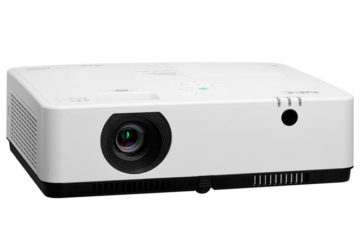
The NEC NP-MC372X is an entry-level 3LCD projector designed for classrooms and offices. It has XGA resolution (1024×768) and a bright 3,700-lumen output. In ECO mode, the lamp can last up to 15,000 hours. Priced at $509, it’s a compact and lightweight option for those who need a reliable, budget-friendly projector.
It’s great for schools and businesses, offering networking features and the ability to display content from multiple sources at the same time, including mobile devices.
NEC NP-MC372X Specs
Price: $509
Technology: 3LCD
Resolution: XGA (1024×768)
Brightness: 3,700 lumens
Contrast: 16,000:1
Zoom Lens: N/A
Lens Shift: N/A
Lamp Life: Up to 15,000 hours (ECO mode)
Weight: Compact and lightweight
Warranty: Standard coverage
Overview
The NEC MC372X is a compact XGA (1024×768) 3LCD projector with a 1.2x zoom lens and 3,700 ANSI lumens of brightness. It can even accept 4K@30P content via HDMI. It has USB 2.0A and a LAN port for network control and management. The replaceable lamp can last up to 15,000 hours in ECO mode.
Being a 3LCD projector, the MC372X delivers bright, rich colors and higher native contrast than many DLP projectors, with a dynamic contrast ratio of 16,000:1.
NEC offers two series for classrooms: the MC and ME series. The MC372X is the entry-level option, slightly lower in brightness and resolution than the MC382W ($559, WXGA, 3,800 lumens). For more flexible placement, the ME series offers a larger zoom (1.7x) and wider throw, including the ME382U (WUXGA, 3,800 lumens, $919).
The MC372X is a solid, budget-friendly choice for presentations, photos, or documents in classrooms or meeting rooms.
Highlights
3,700 lumens (color & white)
$509 list price
Lamp life up to 15,000 hours (ECO mode)
XGA resolution (1024×768)
3LCD technology
16,000:1 dynamic contrast
Keystone correction for flexible placement
Virtual remote
PC-free presenting via USB and built-in media player
MultiPresenter – connect up to 16 devices (wired/wireless, wireless needs NP05LM1)
Screen mirroring for iOS & Android
NaViSet Administrator 2 & Crestron Roomview support
16W mono speaker
3-year parts & labor warranty (1 year on lamp, includes InstaCare next-day exchange)
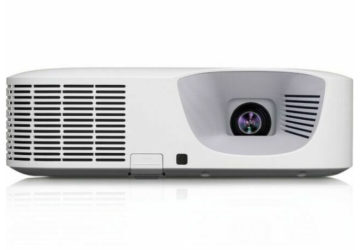
The Casio XJ-F211WN is a DLP projector with WXGA (1280×800) resolution and a solid-state light engine. It’s great for both business and education, fitting well in K-12 classrooms, school conference rooms, office meeting rooms, and boardrooms. Priced at $1,049.99, it earned a Special Award for Value Solid State in our Classroom Projectors Report.
Here’s what we’ll cover: a quick overview and key highlights, a look at its hardware, a deep dive into picture quality and performance, and finally a summary with pros, cons, and how it stacks up against the competition.
Casio XJ-F211WN Specs
Price: $1,049.99
Technology: DLP
Native Resolution: WXGA (1280×800)
Brightness: Not specified
Contrast: Not specified
Zoom Lens Ratio: 1.5:1
Lens Shift: No
Lamp Life: 20,000 hours (solid-state)
Weight: 8.4 lbs
Warranty: Not specified
Overview
The Casio XJ-F211WN is a solid-state projector powered by Casio’s hybrid laser/LED light engine, rated to last up to 20,000 hours. While solid-state projectors usually cost more upfront than lamp-based models, their low maintenance costs balance things out over time. This model is the most affordable solid-state projector we reviewed this year, earning it our Special Award for Value Solid State.
With WXGA resolution (1280×800) and a 16:10 aspect ratio, it’s sharp enough for most business and K-12 uses. Higher resolutions like WUXGA or 4K are only necessary for specialized applications such as graphic design, video production, or medical imaging.
Casio claims 3,500 lumens for the F211WN. While our measurements found it lower, it’s still bright enough for standard or large classrooms, as well as most conference or boardrooms.
It offers both wired and wireless networking (wireless via an optional adapter) and comes with Casio’s Education Solutions for easy classroom or meeting integration. These include features like One Click Connection, PC Remote, and Moderator Function.
Highlights:
3,500 lumens (plenty for business/education)
WXGA resolution (1280×800)
20,000-hour laser/LED light engine
1.50:1 zoom lens for flexible placement
16W built-in mono speaker
Dust-resistant design
Quiet operation (33dB full power, 29dB ECO)
Wired and optional wireless networking with education-focused tools
The following projectors won awards in the Higher Education Projector Category:
Best in Classroom Performance Award: Panasonic PT-VMZ50
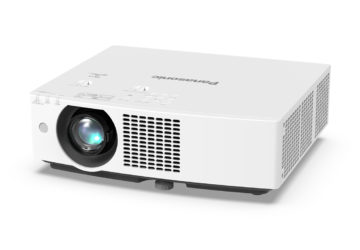
The Panasonic PT-VMZ50 is a business-class 3LCD laser projector with WUXGA resolution (1920 x 1200) and a bright 5,000 lumens output. Priced around $2,499, it delivers strong performance and a solid feature set.
It’s the smallest and lightest 3LCD laser projector in its brightness class, weighing under 16 pounds, making it easy to install or move around. Despite its compact size, it produces excellent picture quality and has plenty of features for meeting rooms and classrooms alike.
The PT-VMZ50 uses a laser/phosphor light engine rated for 20,000 hours of maintenance-free use. Its 3LCD technology delivers bright, rich colors—better than what’s typical from single-chip DLP projectors.
It comes with all the expected business-class features: horizontal and vertical lens shift, good zoom range, plenty of input options, plus wireless control and connectivity. Though aimed at business use, it’s equally at home in educational environments.
Panasonic PT-VMZ50 Specs
Price: $2,499
Technology: 3LCD
Resolution: WUXGA (1920 x 1200)
Brightness: 5,000 lumens (claimed)
Contrast Ratio: 3,000,000:1
Zoom Lens: 1.6x
Lens Shift: Yes
Light Source Life: 20,000 hours (laser)
Weight: 15.9 lbs
Warranty: 3 years
The Panasonic PT-VMZ50U is a compact, 5,000-lumen WUXGA business projector with a laser/phosphor light engine that lasts up to 20,000 hours without maintenance.
It sits in the middle of Panasonic’s portable WUXGA laser lineup, between the 4,500-lumen PT-VMZ40U and the 6,000-lumen PT-VMZ60U. All share the same lightweight chassis (about 16 lbs, 16”W x 5”H x 14”D). Panasonic also makes two WXGA versions — the PT-VMW50U (5,000 lumens) and PT-VMW60U (6,000 lumens).
Panasonic calls the PT-VMZ50U the world’s smallest and lightest 3LCD projector at 5,000 lumens, and it’s certainly easy to move around. The 3LCD imaging delivers richer colors than many single-chip DLP projectors, and precise laser control gives it a huge dynamic contrast ratio of 3,000,000:1.
It offers manual vertical and horizontal lens shift, a 1.6x zoom lens, dual HDMI ports, and a DIGITAL LINK/LAN (HDBaseT) input. It can even handle 4K@30P signals for sharper detail. A USB port lets you show photos directly or connect the optional wireless module for easy streaming from laptops or mobile devices.
Highlights:
5,000 lumens (color & white)
$2,499 minimum advertised price
Laser light engine (up to 20,000 hours)
WUXGA resolution (1920 × 1200)
Supports 4K@30P via HDMI or Digital Link (HDBaseT)
3LCD technology with 3,000,000:1 contrast
Vertical & horizontal lens shift for flexible mounting
Works vertically or at any angle
3x digital zoom for close-up detail
Apps/software for wireless projection (optional module)
Advanced networking & HDBaseT support for long cable runs
Reusable air filter
Built-in 10W speaker
3-year warranty
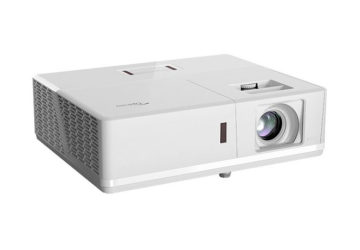
The Optoma ZU506T-W is a laser installation projector that delivers 5,000 lumens of brightness and WUXGA resolution (1920 × 1200), giving you a bit more vertical detail than standard 1080p. With a 300,000:1 contrast ratio (when Extreme Black is enabled), it produces sharp, high-quality images.
It’s loaded with connectivity options, including 2 HDMI ports, Composite video, HDBaseT, and dual VGA inputs. Thanks to its laser light source, it stays bright for years and is an ideal upgrade for older, dim projectors in conference rooms, classrooms, or places of worship.
The ZU506T-W features vertical lens shift, 4-corner geometric correction, and a 1.6x zoom, allowing projection from as close as 3.28 feet to as far as 32.8 feet. It’s bright enough to handle ambient light, so you won’t need to darken the room just to see your content clearly.
Whether you’re replacing a faded projector in a church, upgrading a hard-to-read conference room display, or refreshing a classroom setup, the ZU506T-W offers flexible installation, strong performance, and a crisp, vibrant picture.
In this review, we’ll kick things off with a quick overview of the ZU506T-W, highlighting its key features and standout capabilities. We’ll explore its hardware in detail, including the remote and control panel, then dive into picture quality and performance—complete with example images and recommended viewing settings. Finally, we’ll wrap it all up with a clear list of pros and cons so you can easily decide if the Optoma ZU506T-W is the right choice for your business or educational needs.
Optoma ZU506T Specs
Price: $2,799
Technology: DLP
Resolution: WUXGA (1920 x 1200)
Brightness: 5,000 lumens
Contrast Ratio: 300,000:1
Zoom Lens: 1.6x
Lens Shift: Yes
Light Source Life: Up to 30,000 hours
Weight: 12.12 lbs
Warranty: 5 years or 12,000 hours on the light source (whichever comes first) and 3 years parts & labor on the projector
Overview
The Optoma ZU506T-W is a professional installation laser projector designed for big, bright, and long-lasting performance. With 5,000 lumens of brightness, it delivers vibrant, clear images even in well-lit rooms. Its laser phosphor light source can last up to 30,000 hours, which is an incredible jump from the old 1,000-hour lamps. For most conference rooms that run only 4–5 hours a day, this projector could easily last two decades—a fantastic return on investment.
Priced between $2,799 and $2,999, it’s a great deal considering it might be the last projector you’ll ever need. It comes with a 3-year or 20,000-hour warranty, plus Optoma Express advanced exchange service for quick replacements if something goes wrong.
This projector isn’t just about long life—it’s loaded with features. It has a WUXGA (1920×1200) resolution, supports 4K input via HDMI 2.0, and offers plenty of connection options, including RS232, RJ45 networking, and HDBaseT for single-cable setups. It’s compatible with Crestron, AMX, and other control systems, making it easy to integrate into professional AV setups.
It even includes two 10W stereo speakers, more powerful than what most projectors in its class offer. Advanced tools like 4-corner geometric correction and DICOM simulation mode make it flexible enough for everything from business presentations to medical training.
Highlights:
Price: $2,799
5,000 ANSI lumens brightness
WUXGA (1920×1200) resolution with 4K input support
Laser phosphor light source – up to 30,000 hours
Vertical lens shift and 1.6x zoom
4-corner correction
RS232, LAN, HDBaseT for control and networking
2 HDMI, 2 VGA, USB power for streaming devices
2 x 10W stereo speakers
DICOM simulation mode for medical imaging
Direct power on and signal power on options
Best in Classroom Value Award: Casio XJ-S400UN
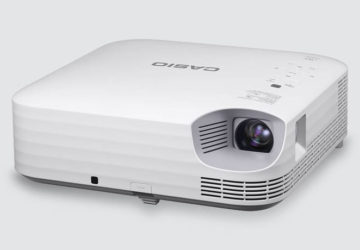
The Casio XJ-S400UN is part of Casio’s new Superior Series, featuring their next-generation mercury-free hybrid laser and LED light engine. Announced in January, this series also introduces a dust-resistant design that helps keep the light source and power supply cool while preventing dust from building up inside—even in dusty environments.
This DLP projector is designed for business and education use. It offers WUXGA (1920×1200) resolution and is compact enough to be easily moved between meeting rooms or classrooms. With a 4,000-lumen brightness, it can easily handle the ambient light found in schools, offices, boardrooms, retail spaces, or museum exhibits.
Overview
The Casio XJ-S400UN is a business and education projector with WUXGA (1920×1200) resolution and DLP technology. It uses Casio’s upgraded R-Laser & LED Hybrid Light Source, which lasts up to 20,000 hours—enough for about 18 years of school use at six hours a day.
With 4,000 lumens, it’s bright enough to handle rooms with lots of ambient light. The 1.70:1 zoom lens gives you flexibility in placement, and since it has no lamps or filters, it’s virtually maintenance-free. While its $1,949.99 price is higher than many lamp-based projectors, the long lifespan and zero maintenance costs make it a cost-effective choice over time.
The XJ-S400UN is Crestron RoomView compatible for network control, supports wired and optional wireless LAN, and includes education-friendly features like moderator mode for sharing student work, the C-Assist app for remote control, and a 16W speaker for clear audio.
Key Highlights
$1,949 list price
4,000 lumens brightness
WUXGA (1920×1200) resolution
DLP technology
1.70:1 zoom ratio
20,000:1 contrast ratio
R-Laser & LED light source (20,000 hours)
No lamps or filters—low maintenance
Wired & wireless LAN (optional dongle)
Auto input search & quick projection
16W mono speaker
3-year warranty (projector & light source)
Special Award – Interactive: Maxell MP-TW4011
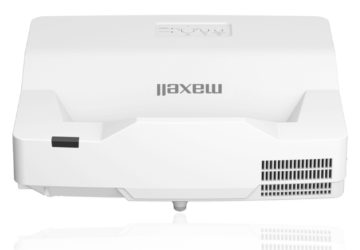
The Maxell MP-TW4011 is an ultra short throw, 3LCD projector with WXGA (1280×800) resolution and 4,200 lumens brightness. It uses a laser light engine, which means low maintenance, and it also supports interactivity—a feature that’s becoming popular in classrooms and business presentations for more engaging lessons or meetings.
Fun fact: On April 1, 2019, Hitachi-branded projectors became part of the Maxell brand. Maxell focuses heavily on the education market, so this review will highlight its use in classrooms, though it’s also suitable for business.
We’ll start with an overview and key highlights, then dive into special features, hardware, and picture performance. At the end, we’ll summarize with pros, cons, and how it stacks up against the competition.
Maxell MP-TW4011 Specs
Technology: 3LCD
Native Resolution: WXGA (1280×800)
Brightness: 4,200 lumens
Contrast: 500,000:1
Ultra-short throw & interactive
Low-maintenance laser light engine
Overview
The Maxell MP-TW4011 is an ultra short throw, laser projector built for classrooms and education environments. Its laser light engine can last up to 50,000 hours in Long Life 2 mode—that’s nearly 46 years if used six hours a day in a 180-day school year!
This projector uses WXGA (1280×800) resolution, which is basically 720p for schools and businesses. It’s perfect for presentations, videos, and lessons. Most K-12 classrooms don’t need higher resolutions, though high school classes doing film, graphic design, or CAD might benefit from WUXGA or 4K.
With 4,200 lumens, it can easily handle bright classrooms. Its ultra short throw design means it can sit just inches from the screen, reducing shadows and preventing blinding light for teachers and students.
The MP-TW4011 is also interactive, supporting up to six users with pen or finger input, and comes with StarBoard interactive software—no yearly subscription required. It has plenty of connectivity, including HDMI with MHL for streaming, wired and optional wireless LAN, and works with Windows, Mac, and Chromebooks.
Pricing: MSRP $4,239, street price around $2,829. While a bit higher, the long-lasting laser, UST design, and interactive features make it worth it, especially for high school classrooms.
Maxell MP-TW4011 Highlights
4,200 Lumens
3LCD Technology
WXGA (1280×800) Resolution
Ultra Short Throw (up to 110” diagonal)
500,000:1 Contrast Ratio
Laser Light Engine – up to 50,000 hours
Interactive Touch (pen or finger, up to 6 users)
Powered Focus & Perfect Fit
High Dynamic Range (HDCR2)
Wired & optional Wireless LAN
Compatible with Windows, Mac, Chromebook
16W Mono Speaker
StarBoard Software Included
Warranty: 5 years parts & labor, up to 20,000 hours on light source
2020-2021 Best in Classroom: High-End Specialty/Large Venue Projector Award Winners
The following projectors won awards in the Higher Education Projector Category:
Best in Class Performance Award: NEC PX1005QL
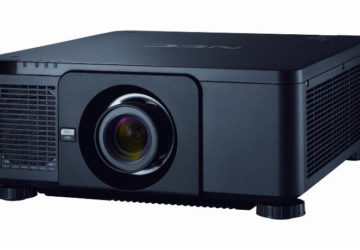
The NEC NP-PX1005QL is a 10,000-lumen, 4K DLP projector designed for large venues. It features WQXGA resolution (3840 x 2160) and can handle a full range of 4K content. This commercial-grade projector is ideal for higher education, corporate events, houses of worship, and digital signage. It uses a laser/phosphor light engine rated for 20,000 hours and a single DLP chip to deliver sharp 4K UHD images.
NEC’s PX-Series has twelve models, all using DLP technology. Brightness ranges from 8,000 lumens on the NP-PX803UL up to 10,000 lumens on the NP-PX1005QL. There are three chassis options, each available with or without the standard lens and in black or white. The model reviewed here is the white NP-PX1005QL-W, with a black version called NP-PX1005QL-B.
NEC NP-PX1005QL Specs (Highlights)
Technology: DLP
Native Resolution: 3840 x 2160 (4K UHD)
Brightness: 10,000 lumens
Contrast: 10,000:1
Lens Shift: No
Light Engine: Laser/Phosphor, 20,000-hour life
Ideal for large venues and installation applicationsOverview
The NEC NP-PX1005QL is a 4K UHD WQXGA (3840 x 2160) DLP projector built for large venues. Unlike many projectors in its class, it can display 4K content natively without relying on pixel-shifting, delivering sharp and clear images.
It features motorized zoom and focus plus vertical (+50%/-30%) and horizontal (+20%/-10%) lens shift. While it doesn’t come with a lens, it supports eight interchangeable bayonet-style lenses, covering throw distances from 1.6 ft to 183 ft. The standard lens provided for review was the NP18ZL-4K, a mid-throw zoom lens (1.71–2.25).
As a large venue installation projector, it includes edge blending, geometric correction, and advanced installation features. Connectivity options are robust: wired LAN, HDBaseT (up to 100 meters), DVI-D, HDMI 2.2 for 4K, multiple audio inputs, RS-232c, BNC, service port, and wired remote input.
Key Highlights:
10,000 lumens brightness
List Price: $24,000
Laser light engine, up to 20,000 hours
Native 4K UHD (3840 x 2160)
10,000:1 contrast ratio
Supports 4K, HDR, and Blu-ray UHD
Vertical and horizontal lens shift for flexible installation
Lens Memory (10 presets) and User Modes (10 presets)
Can be mounted vertically or at any angle
Split-screen (picture-by-picture) capability
Edge blending and projection mapping support
Advanced geometric correction
Digital zoom up to 4×
Wired and optional wireless networking
HDBaseT for long-distance HDMI over CAT6
Supports Crestron Roomview, AMX Beacon, PJ Link
5-year warranty with NEC InstaCare rapid replacement
Best in Class Value Award: Christie LHD878-DS
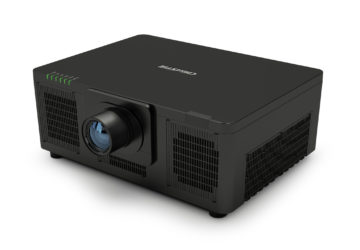
The Christie LHD878-DS is a 7,800-lumen laser projector with Full HD (1920 x 1080) resolution that can handle 4K content. It’s part of Christie’s DS-Series of mid-brightness business and installation projectors, ideal for classrooms, museums, and mid-sized auditoriums.
Christie offers three laser projectors in this series: the LWU755 (7,000 lumens) and LWU900 (8,000 lumens) are WUXGA, while the LHD878-DS is the only Full HD option. Its laser light engine can last up to 50,000 hours in 50% light mode.
The projector doesn’t include a lens, but there are seven lens options, including an ultra-short throw (UST) version.
Christie Specs :
7,800 ANSI lumens
Full HD (1920 x 1080) resolution
3LCD technology
Accepts 4K content
Laser light engine up to 50,000 hours
Multiple optional lenses, including UST
Designed for classrooms, museums, and mid-sized auditoriums
Overview
The Christie LHD878U is a mid-brightness, business-class projector delivering up to 7,800 lumens with a reliable laser light engine. Part of Christie’s DS-Series, it offers high performance without breaking the budget.
It has a Full HD (1920 x 1080) resolution but can accept 4K@60P content. The laser light engine lasts up to 50,000 hours in low-power mode, and as a 3LCD projector, it produces bright, vibrant colors—perfect for lecture halls, museums, auditoriums, and houses of worship.
The projector doesn’t come with a lens, but it’s compatible with seven powered Christie lenses, giving plenty of placement flexibility. Its wide input options and features like omnidirectional mounting, edge blending, and projector warping make it highly versatile.
Highlights:
7,800 lumens (color and white)
Accepts 4K@60P content, Blu-ray UHD compatible
Dynamic iris for deeper blacks
Laser light engine: 20,000 hours (50,000 in low-power mode)
Split-screen capability (PoP and PiP)
Seven lens options for flexible placement
3G-SDI for 1080p video over coax (up to 100m)
HDBaseT for long HDMI runs over CAT6
Multiple inputs: DisplayPort, HDMI, VGA, etc.
Share content via PC, mobile, or LAN
Advanced networking (wireless optional)
Edge blending and projection mapping
Works vertically and at any angle
Supports 24/7 operation
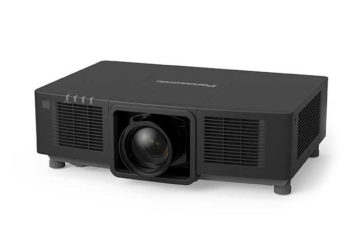
The Panasonic PT-MZ16KL is a high-end, ultra-bright laser projector designed for large lecture halls, museums, and other big venues. It delivers a staggering 16,000 lumens with WUXGA resolution (1920×1200) and excellent out-of-the-box color quality.
Using multiple liquid-cooled laser modules, it keeps running near full brightness even if one diode fails. Its compact chassis packs tons of features, including edge blending, projection warping, and support for seven different lenses, from short-throw to long-zoom options.
The rear Information Monitor shows projector status like temperature, runtime, active signals, and error codes, making setup and monitoring simple. Connectivity is comprehensive, with DVI-D, HDMI 2.0b, HDBaseT, and 3G-SDI.
Highlights:
16,000 lumens brightness (measured: 16,107)
WUXGA resolution (1920×1200)
3LCD laser technology, 20,000-hour light engine
Out-of-the-box accurate colors
Seven lens options for maximum installation flexibility
Edge blending and projection warping for large or curved screens
Rear information monitor for easy status tracking
Wide variety of inputs: DVI-D, HDMI 2.0b, HDBaseT, 3G-SDI
Compact design for a high-brightness projector
Warranty: 3 years parts and labor
